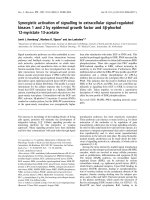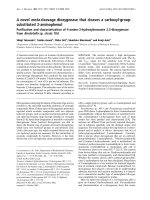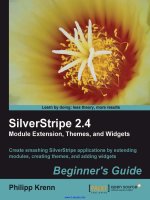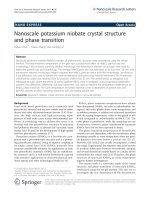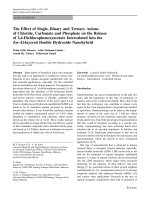2 4 crystal growth and phase diagrams
Bạn đang xem bản rút gọn của tài liệu. Xem và tải ngay bản đầy đủ của tài liệu tại đây (4.4 MB, 29 trang )
Mineral Stability
What controls when and where a
particular mineral forms?
Commonly referred to as “Rock cycle”
Rock cycle: Mineralogical changes that occur
because of variations in geologic environment
Knowing answer provides information
about earth history or processes
Mineral formation
Why would you want to know earth
history or processes:
Find: ore deposits, oil and gas, building
materials
Understand engineering hazards, water cycle
Understand how humans effect the earth:
climate…
The Rock Cycle
A system for
organizing
mineralogical
changes
Fig. 5-1
Bowen’s reaction series
Fe, Mg - silicates
Changing composition
Ca, Na - silicates
Ca, Na, Fe,
Mg - silicates
K-spar
Qtz
3 requirements for
mineral stability
Constituents
Available reactants/elements (X)
Correct environmental conditions (energy)
Pressure (P)
Temperature (T)
Mineral Stability
More stable position is one of lower
energy
Minerals may not be stable – e.g.
metastable minerals
Mineral contains more energy than expected
from their environment
Energy required to overcome metastability
– activation energy
Activation Energy:
- energy to shake book off
shelf
- Energy required to change
mineral phases
Fig 5-2
How can stability be estimated?
Algebraically:
Physical chemistry/Thermodynamics
Estimates of ∆G – Gibbs free energy
Graphically – “phase diagrams”:
Essentially figures of solutions to ∆G problems
Many types, common ones:
One component – P & T variable, X fixed (i.e. the
component)
Two (or more) components – T & X variable, P
fixed
Components and Phases
Component – Chemical entity
H2O
Al2SiO5
Phase – physically separable part of a
system; e.g.
for H20: ice, water, water vapor
for Al2SiO5: Sillimanite, Kyanite, Andalusite
One and two component phase diagrams
Several types of 2-component diagrams
One component diagrams
Fields – where only one phase (mineral) is
stable
Lines – where two phases are stable
simultaneously
Points – where three phases are stable
One component diagrams
If P and/or T changes
One phase converts to another
Examples:
H2O – component; ice, water, and vapor are
phases
Al SiO – component; Kyanite, Andalusite,
2
5
Sillimanite are phases
Al2SiO5 Phase
diagram
∆G = f(P,T)
Phase with lowest ∆G is
stable
Lines mark boundaries of
regions with the lowest
∆G
Very useful to remember
for metamorphic
reactions
Fig. 5.3
H2O phase diagram
Only component
is H2O
More complete H2O diagram
There are 15
polymorphs of ice
Ice IX stability:
T < 140 K
2 kbar < P < 4 kbar
Commonly shown P
& T conditions
tetragonal
Ice 9: Kurt Vonnegut, Cat’s Cradle, melting T = 45.8ºC at P = 1 Atm
Two component phase diagrams
What happens if there are two
components in a system?
Example: Plagioclase feldspars – two
components with complete solid solution
(at high T, otherwise “exsolution”)
Albite– NaAlSi3O8
Anorthite – CaAl2Si2O8
Any composition in between the two end
member compositions
How does solid (and melt) composition
vary during crystallization?
How does composition vary as solids melt
melt to form magma?
OR…
If you know the composition of a
plagioclase feldspar, can you determine T
and P of crystallization?
Two component phase diagram with
complete solid solution
= Na, Ca, Al, SiO2
= (Na,Ca)xAlySizO8
100% Albite
– NaAlSi3O8
Mole % Anorthite
100% Anorthite
– CaAl2Si2O8
Equilibrium Crystallization
Start
An77
An68
End
100% Albite
– NaAlSi3O8
Mole % Anorthite
An55
100% Anorthite
– CaAl2Si2O8
(1) The crystals are always in equilibrium with the melt
(2) Minerals have homogeneous compositions throughout
Fig. 5-14a
Lever Rule
%B = qr/qs
%A = rs/qs
Fraction of two components relate
to the relative lengths of tie lines
Fig. 5.5
Non-equilibrium crystallization
Results in “zoning”
Individual mineral grains may vary in
composition from center to edge
Easily observed petrographically
Very common in plagioclase feldspars
Zoned Plagioclase crystal
Oscillatory zoning
Fig. 12-12
Other types of zoning
include:
(1)Normal zoning (Carich centers)
(2)Reverse zoning (Narich centers)
Zoning reflects change in P and T when
mineral crystallizes
Crystallizing mineral in disequilibrium with
composition of melt
Can be explained by non-equilibrium
crystallization using phase diagram
Non-Equilibrium Crystallization
Start
Normal Zoning
An77
An77
An77
An68
An55
Mole % Anorthite
Minerals show zoning –
heterogeneous compositions
Fig. 5-14b
Controls on zoned crystals
Diffusion rate through solid crystal
Time allowed for diffusion to occur
Diffusion is rapid in olivine – few zoned
crystals
Mostly equilibrium
Diffusion slow in plagioclase
Commonly zoned
Two component phase diagram - No solid solution
Ca, Mg, Al, SiO2 =
At me diopside, anorthite, and melt present
Fig. 5.4
At me, diopside begins xtll, anorthite continues xtll NO HEAT LOST –
remains 1237º C – until all solid. Composition is 75% An, 25% Di. When
first reach 1237º C, system is 48% anorthite, 52% melt

